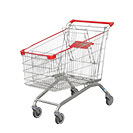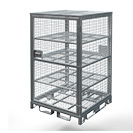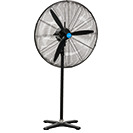Optimising Waste Management with Waste Carts
Date Posted:19 September 2024
Waste carts are an invaluable tool for efficient and effective waste management. They offer numerous benefits, including improved efficiency, versatility, safety, and hygiene.
Effective waste management is crucial for maintaining cleanliness and efficiency in various settings, from industrial sites to commercial spaces. Waste carts are an essential tool in this process, designed to streamline the collection, transport, and disposal of waste. This blog explores the benefits of waste carts, how to select the right cart for your needs, and best practices for their use.
The Role of Waste Carts in Waste Management
Waste carts play a significant role in waste management by offering a practical solution for handling and transporting waste materials. Their benefits include:
- Efficiency: Waste carts are designed to make waste collection and transport more efficient. They can handle large volumes of waste, reducing the number of trips needed to dispose of or recycle materials. This improves productivity and minimises downtime.
- Versatility: Available in various sizes and designs, waste carts can be used in a wide range of environments, including offices, warehouses, factories, and hospitals. Their adaptability makes them a valuable addition to any waste management system.
- Safety: Proper waste handling is crucial for maintaining a safe work environment. Waste carts help reduce the risk of accidents associated with manual lifting and carrying. They allow for easier movement of waste materials, thereby improving workplace safety.
- Hygiene: Waste carts with enclosed designs or lids help contain waste and prevent spills. This contributes to a cleaner and more hygienic environment, reducing the risk of contamination and unpleasant odours.
Choosing the right Waste Cart
Selecting the appropriate waste cart involves considering several factors to ensure it meets your specific needs:
- Capacity: Choose a waste cart with the right capacity for your waste management requirements. Larger carts are ideal for high-volume waste, while smaller carts may be more suitable for areas with less waste. Consider the volume of waste generated and the frequency of disposal.
- Material and Durability: Waste carts are typically made from materials such as heavy-duty plastic or metal. Plastic carts are lightweight and resistant to rust, making them suitable for indoor use. Metal carts, on the other hand, offer greater durability and are ideal for heavy-duty applications.
- Design and Features: Consider the design features of the waste cart, such as wheels, handles, and lids. Wheels should be sturdy and able to navigate different surfaces smoothly. Handles should be ergonomic for comfortable pushing and manoeuvring. Lids and covers help control odours and keep waste contained.
- Mobility and Maneuverability: Waste carts should be easy to move and manoeuvre, especially in tight or congested spaces. Look for carts with swivel wheels and a design that facilitates easy movement across various surfaces.
- Compliance and Safety: Ensure the waste cart complies with relevant safety and regulatory standards. This includes features such as rounded edges and non-slip surfaces to prevent accidents and injuries.
Best Practices for using Waste Carts
To maximise the effectiveness of waste carts, follow these best practices:
- Regular Maintenance: Perform regular maintenance on waste carts to keep them in good working condition. Inspect wheels, handles, and other components for wear and tear. Address any issues promptly to ensure the cart remains functional and safe to use.
- Proper Use: Train employees on the proper use of waste carts to ensure they are used effectively and safely. This includes instructions on how to load and unload waste, as well as how to handle the cart to avoid accidents.
- Routine Cleaning: Clean waste carts regularly to prevent the build-up of waste residues and odours. This helps maintain hygiene and extends the lifespan of the cart. Use appropriate cleaning agents and methods based on the material of the cart.
- Effective Waste Segregation: Use separate waste carts for different types of waste, such as recyclables, general waste, and hazardous materials. This facilitates proper segregation and recycling, improving the efficiency of your waste management system.
- Optimise Collection Routes: Plan collection routes to minimise the distance and time spent moving waste carts. This can help improve overall efficiency and reduce the risk of accidents during waste collection.
Waste carts are an invaluable tool for efficient and effective waste management. They offer numerous benefits, including improved efficiency, versatility, safety, and hygiene. By choosing the right waste cart for your needs and following best practices for use and maintenance, you can enhance your waste management processes and contribute to a cleaner, more organised environment. Investing in high-quality waste carts not only supports operational efficiency but also promotes sustainability and workplace safety.






















































































 Trolleys & Hand Trucks
Trolleys & Hand Trucks Cage Trolleys
Cage Trolleys Cleaning Carts & Trolleys
Cleaning Carts & Trolleys Construction Trolleys
Construction Trolleys Custom Trolleys
Custom Trolleys Hand Trucks & Dollies
Hand Trucks & Dollies Laundry/Linen Trolleys
Laundry/Linen Trolleys Lifting Trolleys
Lifting Trolleys Order Picking Trolleys
Order Picking Trolleys Panel Cart Trolleys
Panel Cart Trolleys Platform Trolleys
Platform Trolleys Powered Trolleys
Powered Trolleys Shelf & Tiered Trolleys
Shelf & Tiered Trolleys Shopping Trolleys
Shopping Trolleys Stainless Steel Trolleys
Stainless Steel Trolleys Tool Trolleys
Tool Trolleys Utility & Service Carts
Utility & Service Carts Lifting & Handling Equipment
Lifting & Handling Equipment Forklift Attachments
Forklift Attachments Jib Attachments
Jib Attachments Lifting Hoists & Pallet Hooks
Lifting Hoists & Pallet Hooks Load Skates & Tow Tugs
Load Skates & Tow Tugs Manual Stackers & Lifters
Manual Stackers & Lifters Pallet Jacks
Pallet Jacks Pallet Lifters
Pallet Lifters Pallet Rotators & Dispenser
Pallet Rotators & Dispenser Powered Pallet Trucks & Electric Lifters
Powered Pallet Trucks & Electric Lifters Scissor Lift Trolleys and Tables
Scissor Lift Trolleys and Tables Conveyor Equipment
Conveyor Equipment Conveyor Frames & Stands
Conveyor Frames & Stands Roller & Skate Conveyors
Roller & Skate Conveyors Ladders & Access Equipment
Ladders & Access Equipment Container & Yard Ramps
Container & Yard Ramps Ladders & Step Stools
Ladders & Step Stools Work Platforms & Crane Cages
Work Platforms & Crane Cages Drum Handling Equipment
Drum Handling Equipment Drum Storage & Bunding
Drum Storage & Bunding Drum Trolleys & Lifters
Drum Trolleys & Lifters Forklift Drum Handling
Forklift Drum Handling Waste Handling & Bins
Waste Handling & Bins Bin Lifters & Tippers
Bin Lifters & Tippers Plastic Waste & Wheelie Bins
Plastic Waste & Wheelie Bins Steel Waste & Tipping Bins
Steel Waste & Tipping Bins Waste Carts
Waste Carts Dangerous Goods Storage & Spillage
Dangerous Goods Storage & Spillage Aerosol Cans Storage Cages
Aerosol Cans Storage Cages Bunded Pallets & Storage
Bunded Pallets & Storage Corrosive Goods Storage Cabinets
Corrosive Goods Storage Cabinets DG Storage & Trolleys
DG Storage & Trolleys Flammable Liquid Cabinets
Flammable Liquid Cabinets Forklift Gas Storage Cages
Forklift Gas Storage Cages Site Storage
Site Storage Spill Kits
Spill Kits Shelving & Storage Equipment
Shelving & Storage Equipment Stillage & Transport Cages
Stillage & Transport Cages 750 Series Cage Configurations
750 Series Cage Configurations Heavy Duty Cabinets
Heavy Duty Cabinets Heavy Duty Shelving
Heavy Duty Shelving Mega Bins & Pallets
Mega Bins & Pallets Packing & Workbenches
Packing & Workbenches Parts Trays & Stor-Pak Bins
Parts Trays & Stor-Pak Bins Pegboard & Louvre Panels
Pegboard & Louvre Panels Plastic Bins & Crates
Plastic Bins & Crates Plastic Handling Solutions Bins
Plastic Handling Solutions Bins Plastic Pallets
Plastic Pallets Stack & Nest Bins
Stack & Nest Bins Pallet Racking Accessories
Pallet Racking Accessories Workplace Equipment
Workplace Equipment Modular Workbenches
Modular Workbenches Electric Height-Adjustable Workbenches
Electric Height-Adjustable Workbenches Floor Matting
Floor Matting General Workplace Equipment
General Workplace Equipment Industrial Weighing Scales
Industrial Weighing Scales Packaging Machinery
Packaging Machinery Stationery Cupboards
Stationery Cupboards Storage and Stillage Cages
Storage and Stillage Cages Tool Trolleys
Tool Trolleys Tooling Cabinets
Tooling Cabinets Workshop Fans and Coolers
Workshop Fans and Coolers Safety Barriers, PPE & Signage
Safety Barriers, PPE & Signage Barriers & Bollards
Barriers & Bollards First Aid Equipment
First Aid Equipment Gloves, Knives and PPE
Gloves, Knives and PPE Signage
Signage Cleaning & Site Supplies
Cleaning & Site Supplies Cleaning Equipment
Cleaning Equipment Cleaning Trolleys
Cleaning Trolleys Rubbish Bins
Rubbish Bins Signs & Traffic Supplies
Signs & Traffic Supplies Construction Equipment
Construction Equipment Construction Trolleys
Construction Trolleys Waste Handling
Waste Handling General Site Equipment
General Site Equipment Concrete Equipment
Concrete Equipment Site Storage
Site Storage Lifting Equipment
Lifting Equipment










